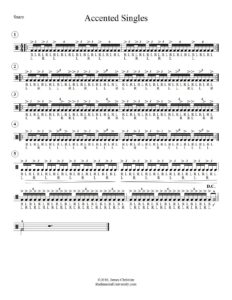
Accented Singles: One of the Best Things You Can Practice for Any Percussion Instrument
If you want to get the most bang for your buck in practice sessions, devote regular time to working on your accented singles. I think this exercise is extremely helpful for all percussionists, whether you play snare drum, keyboards, timpani, drum set, congas, or anything else.
Why is this exercise so great? Because singles are the foundation of everything. If you can’t play fast singles and control them with accents, then you’re going to have a hard time playing anything else very well. But if you take time and develop your singles, then everything else flows from that foundation.
This exercise has five sections; #1-4 repeat, and #5 adds a final endurance element. If you are a younger player, I would highly recommend playing just #1 over and over again (like for a month or two) until you have it sounding really good and up to a tempo of 100 bpm on the metronome. If you are already at that level, then the remaining sections provide some extra challenges with accent control and pure endurance.
At the end of the exercise, you will notice there is a “D.C.” marking—which, of course, means to go back to the very beginning and play the entire exercise again. On the second lap, follow the bottom sticking. The first time through the exercise, you will play everything with right hand lead, and the second time through, you will play everything with left hand lead. At faster tempos, this thing is a workout!
One important note about the accents: Play them! Few things sound worse than weak accents. Make a clear distinction between your accents and taps. For optimal speed, keep your taps low and close to the drum head. Take care to bring out every accent so that the rhythm is clear.
I believe it’s vitally important to practice this exercise on a single surface, such as a snare drum, because the up-and-down motion is a vital skill to master. Once you can play it well on one surface, you may want to practice it on other percussion instruments, such as multi-tenors, timpani, drum set, or keyboards. You can practice by keeping the taps on one surface and moving the accents to another surface. (You could also do the same with the rims on a snare drum.)
Finally, playing accented triplets is especially important because you have to alternate hands, and you end up working both hands equally. I would recommend adding this exercise (at least #1) to your daily practice routine. Over the course of a few weeks, you should see significant improvement on snare drum and all percussion instruments that you play.
